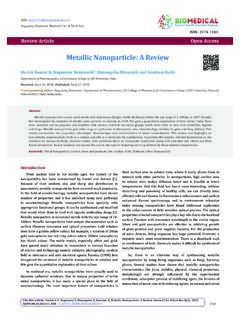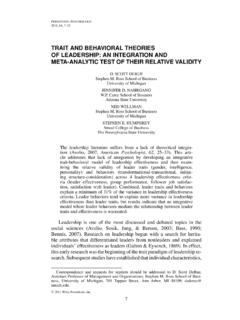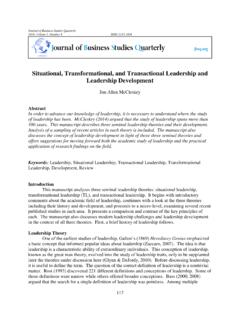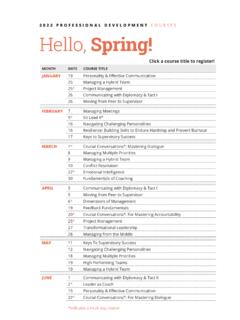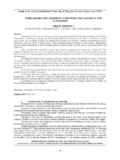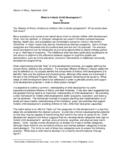Transcription of Nursing Leadership Strategies for Implementing Nursing ...
1 Volume 3- Issue 5: 2018 3534 Nursing Leadership Strategies for Implementing Nursing Full Scope of Practice into Acute Care Team-Led Healthcare SettingsAlexandra Jean Hamilton1, Elke Huber2, Ayah Shakshuki3 and Andrea LO Hebb*2,41 Saint Francis Xavier School of Nursing , St Francis Xavier University, USA2 Dalhousie University School of Nursing , University Avenue, USA3 Dalhousie University College of pharmacy, College of pharmacy, USA4 Dalhousie University, Division of Neurosurgery, USAR eceived: March 26, 2018; Published: April 12, 2018*Corresponding author: Andrea LO Hebb, Saint Francis Xavier School of Nursing 2340 Notre Dame Avenue St Francis Xavier University, Antigonish, Dalhousie University, Division of Neurosurgery, Nova Scotia Health Authority, Halifax, Canada, USA, Email: ISSN: 2574-1241 DOI: LO Hebb.
2 Biomed J Sci & Tech ResCite this article: Alexandra JH, Elke H, Ayah S,Andrea LO He. Nursing Leadership Strategies for Implementing Nursing Full Scope of Practice into Acute Care Team-Led Healthcare Settings. Biomed J Sci &Tech Res 3(5)- 2018. DOI: Review Article Open Access Introduction The Nursing new model of care was introduced in Nova Scotia as an innovative cost-efficient measure to integrate registered nurses (RN) and licensed practical nurses (LPN) in a unified strategy as a team-led holistic initiative to produce best patient outcomes.
3 Such an approach to reorganizing Nursing practice necessitates RNs to work to their full scope of practice. Working to full scope has been interpreted by tasks nurses perform and not what professional regulatory bodies dictate. There is increased RN-LPN tension when LPNs are working to full scope and tasks overlap, a pay differential still occurs. Working to full scope has implications for Nursing Leadership to sustain healthy work environments. The incentive driving creation of innovative Nursing practice models is to contain costs as well as promote retention and recruitment of nurses in acute care [1].
4 Research has only recently addressed the question of the impact of the models effects on patient outcomes [2].The Issue and Implications for Nursing Practice and LeadershipThe issue is two parts. First nurses do not work to full scope of practice and feel their skills are not recognized or valued CNAC [3]. Second, nurses who are practicing full scope have expressed concern and resentment. For instance, in a hospital environment, certain units may primarily employ RNs; however others have teams consisting primarily of LPNs which may result in hostility and resentment from RNs [4].
5 Concerns encompass the possibility of job loss, territoriality, misperceptions about the role of the LPN, a resistance to change and role confusion. The client, scope of practice and practice environment may be factors determining patient assignment in acute care settings CRNNS [5] and CLPNNS [6]. More of the traditional Nursing tasks are being handed to LPNs while RNs are acquiring increased high acuity patients with complex healthcare needs [7]. Scope of practice for LPNs in Nova Scotia includes assessment and evaluating patients, collaborating in developing and Implementing a Nursing care plan CLPNNS [6].
6 LPNs may practice independently given the patient(s) need(s) are not complex and are predictable CRNNS [8]. However, the responsibilities and extent to which duties are performed varies based on employer policies, the practice environment, and of course the complexity of the patient. Complex patients whom are considered to have unpredictable health status are mainly handled by RNs or LPNs under the direction of an RN or another healthcare professional CRNNS [8]. Implications for Nursing practice include support of health organizations in recognizing the full scope of Nursing practice to exploit cost-efficient use of human resources [9].
7 Leadership roles involve establishing a positive work environment, scope clarity, team-building and practice opportunities [10]. emotional intelligence as a basis for Nursing Leadership has been shown to have a positive outcome in the work environment as it supports professional Nursing practice and teamwork between health care providers [11]. Effective Leadership comes with experience and without it deficiencies in care have been presented [11]. Leadership competencies/skills needed to respond effectively to changing models of care require effective decision-making to lead and sustain change (Appendix 1).
8 Historical Background of the Issue, Alternative Explana-tions and Associated AssumptionsHistorically, hospital-based-task-oriented Nursing programs post 1960s progressed to a professional model of Nursing practice directed and grounded by legislation, regulations, standards of Andrea LO Hebb. Biomed J Sci & Tech Res Volume 3- Issue 5: 2018 Biomedical Journal of Scientific & Technical Research (BJSTR)3535practice, code of ethics and Nursing theory. High standard of patient care was afforded by these changes [12]. Team-based Nursing was replaced with patient allocation models in which one nurse assumed responsibility for complete care of clients assigned [13].
9 The Nursing Task Force (1998) was established in response to growing concerns of nurses in their ability to provide safe care and Nursing professional/governmental organizations about Nursing workforce instability and predicted Nursing shortage. Team Nursing reappeared in 2001-02 in NS Nursing Strategy to address the perceived under-utilization of nurses in roles that maximize the use of their knowledge and skills MOHLC [14,15]. Of utmost importance to the proper and full-implementation of a well-structured model of Nursing care is a clear understanding of the full scope of practice for each member on the healthcare team and the structuring of patient care as a team, not a mere division of labor and tasks [16].
10 Failure to adequately function as a team in all patient-care decisions reverts back to patient allocation. Now, however, LPNs are independently caring for patients within acute care settings, without the appropriate skillsets. In these circumstances it has been challenged that this new model of care can result in unsafe, incompetent, unethical care. It has been previously found that a greater ratio of RNs to LPNs on units results in lower hospital related deaths [17,18]. Hence, cutting RN positions for the purpose of reducing the financial burden on the healthcare system may adversely affect patient health outcomes.

